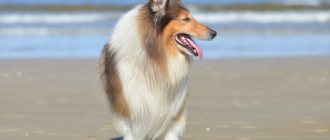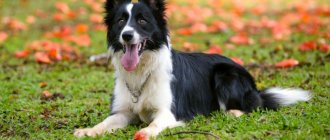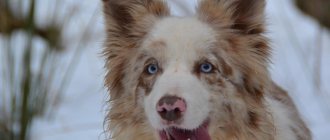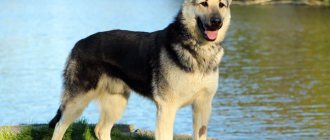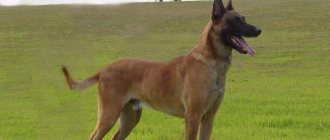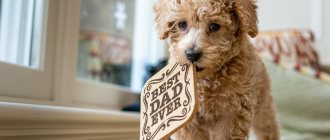The Collie or Scottish Sheepdog (English: rough collie) is a breed of herding dog native to England and Scotland. Originally working dogs, now they are a companion dog and just a friend. Collies come in long-haired and short-haired varieties. In most countries, these two variations are considered separate breeds and cannot be crossed, but in the USA they are considered one and crossbreeding is allowed. Adding to the confusion is the fact that many purebred, mestizos, and aboriginal dogs were called this way. Using the term Scottish Shepherd, cynologists try to separate it from other breeds and clarify it.
Origin story
Scotland is considered the homeland of these dogs, where they quite successfully herded flocks of sheep. Their ancestors were more modest in size and most often had black fur. According to experts, they came to southern England along with nomadic tribes. Subsequently, breeding activities were aimed at further developing their herding abilities. They managed not only sheep, but also goats and pigs.
Collies received their further development thanks to the fact that Queen Victoria turned her attention to the dogs, and she brought several representatives of the breed to England. Here they quickly gained popularity, and many dog breeders became interested in breeding them.
In 1860, this dog was presented at an exhibition as a universal Scottish Sheepdog. In the late 80s, collies came to the United States, and in 1986, the first club for fans of this breed was opened here.
Dog breeds with average life expectancy
This list is "motley". The list includes both miniature and large dogs. Regarding the former, I remember, for example, how long toy terriers live . Their age is often limited to 15 years, but even less than 12 dogs rarely please their owners.
The lifespan of a Chihuahua dog will also be 12-15 years. One of the representatives of the breed, by the way, is recognized as the smallest dog in the world. The dog's name is Millie. Her height is 9.5 centimeters. The four-legged animal lives in Puerto Rico.
The smallest chihuahua Millie
Of the large dogs, the average life expectancy differs:
- Afghan hound
- Belgian Shepherd
- bull terrier
- Buryat wolfhound
- Dalmatian
- shorthaired pointer
They all live 12-13 years. The exact indicator depends on several conditions. About them - in the final chapter.
General description of the breed
Each of us learned from our youth that the collie is a dog that you can almost always trust. Her intelligence is enough for five brothers, and her poise and calmness absolutely free her owners from any pitfalls. The Collie is the perfect house dog. This is a surprisingly obedient and affectionate creature, with an embodied predisposition to take care of the younger ones. A sort of wise, older comrade. Also, collies are uniquely peaceful towards other animals.
She will never leave the building, even if it becomes possible for her to do so - because she probably understands that her place is here, close to her family. It is impossible to find a more patient, timid, affectionate and playful friend for your kids than a collie. And, naturally, the sophisticated, aristocratic appearance supports this image of a useful hero. The dogs look simply royal, although they did not immediately become favorites of the highest society.
Initially, the main purpose of this dog (also known as the Scottish Shepherd) was to protect sheep from predators. In this matter, dogs have gained a wonderful reputation, and to this day they can often be seen in the pastures. The name "colley" was borne by a Scottish breed of sheep, which gave its name to the shepherd dogs - colley dog.
The finest hour for the hardworking shepherd came when the British Queen Victoria passed by the pasture during her trip to Scotland. Noticing extraordinary dogs with a gorgeous mane and a long narrow face among the sheep, the queen could not contain her surprise and ecstasy. She immediately expressed her desire to acquire a collie at her own Scottish residence, Balmoral.
Since 1860, these dogs began to appear at exhibitions and gained great fame. This is logical, since in addition to their own decorativeness, they are also extremely gifted. This breed is perfectly trainable, raising it is a pleasure, since diligence and the desire to amuse the owner are inherent in the dog personally by nature.
It is important to realize that collies are active creatures that for centuries have led an extremely active lifestyle, therefore, owners must be prepared for long walks.
Nowadays, in almost all countries, collies are in demand as guard and police dogs. Their intelligence and intelligence, coupled with innate protective instincts, are valued no less than the stranglehold of traditional official breeds. In army times, collies served as messengers, orderlies, and even sappers. Nowadays they are often used as guide dogs - and here they show excellent intelligence and insight.
Breeds with a minimum lifespan
As was said and follows from the list of long-livers, dogs of large breeds die early. This is partly due to the size of the heart. For miniature breeds it has a reserve of working capacity, but for large breeds it works for wear and tear, not corresponding to body weight.
In addition, it is more difficult for large pets to provide the proper level of activity, especially in an apartment. Body weight puts pressure on the skeleton, leading to arthritis and arthrosis. An unbalanced diet is a reason for the development of rickets. For example, it is often found in Great Danes and Mastiffs.
Mastiff breed
The shortest eyelids among dogs are:
1.Bulldogs. They are divided into several varieties. English and French bulldogs live an average of 9 years. Others are limited to 7 years. Life is interrupted mainly due to heart disease and cancer.
They are determined genetically. Inbreeding was used to breed bulldogs. Hence poor health. This was observed among people in royal families.
2. St. Bernards. They rarely live longer than 10 years. The average is 8 years. During this time, St. Bernards manage to go down in history. In Paris, for example, there is a monument to Barry.
He lived back in the 19th century at the monastery of St. Bernard. Barry worked as a lifeguard, protecting 40 people from death.
3. Bassetov. Due to its unique structure, the dog’s body is subjected to excessive stress, despite its average height. Like bulldogs, basset hounds are the result of inbreeding.
Hence the plethora of diseases typical for representatives of the breed. Some ailments are due to the structure. Folded skin, for example, often becomes swollen and irritated. The loose eyelids of Basset Hounds can turn inwards with the ciliated row. An elongated spine is affected by arthritis.
4. Rottweilers. Their heart and hind limbs suffer from massiveness. They account for the majority of breed sores. As a result, Rottweilers live 9-10 years.
5. Dobermans. They are energetic. Long walks, sports, and training are required. Not every owner provides what is needed in due measure. Dobermans begin to literally die of boredom and get sick. For most dogs, the age limit is 11 years.
You can add to the list a discussion on the topic of how long shepherd dogs live . There are 53 varieties of them. Each age is individual. The life of German Shepherds is the shortest. They rarely celebrate their 12th birthday.
Moreover, Germans often live only 5-7 years. The shepherd Gunther managed to make a fortune during this period. The owner bequeathed the funds to the pet. Gunther became the richest dog in the world, as recorded in the Guinness Book of Records.
The richest shepherd named Gunther
Among shepherd dogs there are breeds whose lifespan largely depends on the environment. Caucasians, for example, live in clean areas outside the cities for 3-4 years longer. In megacities, even on private farmsteads, Caucasian Shepherd Dogs rarely celebrate their 12th birthday.
Of the Chinese crested ones are included in the list of those whose life span is short . Some live up to 15 years, but most are limited to 10-12.
It is worth excluding allergens from your pet’s diet, in particular chicken liver. Cresteds are prone to skin reactions. Against this background, the lymph nodes become enlarged, which indicates an increased load on the internal organs. Crested animals also have problem teeth and often develop Perthes disease, which is associated with impaired blood supply.
Breed standard (appearance)
The dog of this breed is found in two types: short-haired and long-haired. Each has its own exterior features.
- Head. Triangular in shape with an elongated muzzle, the transition from the forehead to the nose is smoothed.
- Eyes. Almond-shaped from light brown to black.
- Ears. High-ranking, regular triangular shape. The tips of the ears should hang forward ⅓. But puppies' ears are delicate, and if you constantly stroke the dog's head, the ears will stand up and it will be difficult to put them in the correct shape.
- Tail. Straight saber-shaped, the tip is raised upward. According to the standard, the tail should not curl into a ring.
- Wool. Dense coat with fluffy and soft undercoat. The long-haired breed has long, soft-to-the-touch fur and a fox-like tail. The paws have a characteristic fringe. The smooth coat has a thick, hard coat and a dense undercoat. The coat fits tightly to the body and reliably protects the dog from humidity, cold wind, and heat.
- Colors. There are three color types of long-haired collies: sable, tri-color and blue merle. Sable color can range from fiery red to light sand. Tricolors have black and red markings on the head and paws, less often on the body. The blue merle or merle color is distinguished by its noble silver color with dark spots, black or gray. According to their exterior, merle dogs should have red spots on their paws and head, but their absence is not considered a deviation from the norm. All three colors of the longhaired breed have a chic white collar, which can be whole or broken in one place, a tassel at the end of the tail and white socks on the paws. On the hind legs only the very tips are colored white, the front legs are highly colored, almost to the elbow.
- Paws. Thin, tall, almost straight. The gait is calm with sweeping movements.
- Back. Straight, no sagging.
- Height at withers. For males from 56 to 61 cm, for females from 51 to 56 cm.
- Weight of an adult dog. From 19 to 34 kg, depending on the gender and appearance of the dog.
- Bite. Standard scissor. But due to the anatomical features of the muzzle, it bites the enemy with its front teeth. This helped the dog pull cattle out of a hole or hole without biting them.
Advantages: balanced, intelligent, calm, friendly towards other animals.
Difficulties: Long walks required.
Distinctive features
The first Collies were somewhat larger than modern ones. This is evidenced by the dog standard in the USSR, where the average height is 63-65 cm. Nowadays, shepherd dogs are of average height ( 51-61 cm ), rather squat, well-built, elongated. The sexual type is well defined, females are much smaller. The difference in weight can reach 15 kilograms .
Distinctive features include long thick fur and a fox-like muzzle with cunning shiny eyes. The latest standard was published in 1988, according to which all dogs that do not meet external characteristics are discarded.
- The head is wedge-shaped, narrow, dry. The skull is wide and flat, as are the cheekbones. The stop is weakly expressed, but easily perceptible.
- The muzzle is narrow, rather long, parallel to the lines of the skull. Powerful lower jaw . Scissor bite The cheeks are flat. The bridge of the nose is tilted down.
- The nose is large. Definitely black.
- The eyes are set narrowly, slightly slanted, almond-shaped. Brown and blue colors are allowed.
- The ears are small, set high, but not wide. In an active state, they are raised and slightly tilted forward, in a calm state they are laid back.
- The body is strong and elongated. The topline is straight. The croup is round and sloping. The scruff is smooth and beautiful.
- The tail is set low, hangs down when calm, and is long, reaching the hock joint.
- The limbs are parallel and strong. Long shins are characteristic. The feet are oval, with well-knit toes. The movements are trot-like, light, sweeping.
- The coat is long, straight, thick and hard. Forms feathering on the ears, limbs and tail; mane on chest. There is a soft undercoat.
- Colors: fawn, mahogany, tri-color, black harlequin.
Varieties
There are two types of breed - long-haired and short-haired collies. Both varieties have some differences in appearance and character.
- Long-haired look. A model of aristocracy and obedience. The variety is more massive, males weigh 26-34 kg, females - 19-26 kg. The main distinguishing feature of the exterior is a thick, soft, warm undercoat and long guard. Thanks to his calm, friendly, patient disposition, he is suitable for the role of a companion and nanny.
- Smooth-haired appearance. An elegant and “light” dog. Males weigh 20-29 kg, females - 18-25 kg. The exterior is distinguished by a thick undercoat and short, stiff hair. Compared to their “furry” relatives, they show more activity, curiosity, and sociability. Some representatives of the breed may express distrust of strangers, but they rarely show aggression. Shows good guard and hunting instincts.
Despite the similarity in origin and appearance of the collie and the Sheltie dog, these are two separate breeds. The ancestor of the second is the Border Collie, not the Scottish Sheepdog. Therefore, the Sheltie cannot be considered a miniature collie.
Pros and cons of the breed
A pet in the form of a Scottish Shepherd is suitable for almost everyone. Despite this, before buying a collie puppy, you should familiarize yourself with the main pros and cons of the breed.
Advantages:
1. Intelligence and intelligence. 2. Beauty. 3. Devotion. 4. Love for children. 5. Ability to withstand heat and cold. 6. Lack of aggressiveness.
Care
While short-haired dogs usually do not require much attention (except for occasional brushing), caring for long-haired collies is a hassle. You need to have not only different types of brushes and combs, but also a spray bottle of water, which is necessary so that the collie’s fur is not subject to electrification. You need to comb your dog according to hair growth: start from the neck and gradually move to the body.
Experts advise washing your collie as little as possible. This is really a necessary procedure only after estrus, molting and childbirth. Dogs participating in competitions are washed before exhibitions. However, it is worth remembering that when washing, a special layer of skin is erased, and therefore the dog becomes susceptible to various diseases, especially the Belgian Mastiff. You should carefully clean your collie's ears and also wipe off discharge from the eyes with a cotton swab. Remember, however, that a lot of mucus indicates problems that only a veterinarian can solve!
Video “Characteristics of the Collie Breed”
From this video you will learn everything about the collie breed, how to care for the dog and train it.
Recommended Posts
Standard height and weight of the Cane Corso breed by month
Weight of a puppy and an adult Labrador by month
38 best dog breeds for apartments according to reviews from breeders and owners
Characteristics of the Herder or Herding Dutch Shepherd
History and breed standard of the Shorthaired Collie
Description of the Mini Australian Shepherd Aussie
Feeding
It is important that any dog receives all the necessary microelements and vitamins. All useful substances are contained in dry food, but feeding should not be limited only to them. Your pet needs to eat meat at least a few times a week, which is known to be rich in proteins. It is also useful to give different vegetables (tomatoes, carrots, cabbage), herbs and cereals.
Adult Scottish Shepherds need to be fed twice a day. At the same time, food should not be left in the bowl, but water must be available to the dog at any time of the day.
Diet
You should carefully choose what to feed your Scottish Shepherd, as the breed is prone to allergies and food poisoning. You need to make a choice between dry and wet food. The first includes dry granules, the second includes canned meat for dogs and natural products (meat, vegetables, fruits, milk). Mixing food types is not recommended.
“Drying” should be purchased only of the highest class, containing all the necessary substances. This type of feeding is more economical and convenient, as it does not take time to prepare. Owners will have to create an individual menu themselves, based on the experience of dog breeders and the advice of veterinarians. The table shows foods that should be included in your pet's diet and which should be avoided.
Table - Permitted and prohibited food products
| What is possible | What not to do |
| - Boiled beef; - liver; - eggs; - sea fish fillet; - cottage cheese; - cheese; - porridge; - fresh vegetables; - seaweed; - medicinal herbs in the form of supplements | - River fish; - bones; - peas; - pork; - salo; - pearl barley; - potato; - sweets; - flour products |
The dog must be fed strictly at the same time. Puppies from two to eight months are fed four to five times a day in small portions. By the age of one and a half years, food intake is reduced to three times. An adult dog is fed twice a day.
Scottish Sheepdog nutrition
A dog's health largely depends on its diet and feeding regimen. A dog's nutrition is based on several rules.
- Rule one is a clear time for eating.
- Rule two is the same number of approaches to the bowl.
- The last rule is to rest after eating.
As for the diet, it should not only be balanced, but contain all the necessary minerals and vitamins. The optimal solution is ready-made food. According to experts, mixing human food and food for the collie dog breed is unacceptable.
The list of permitted products is represented by the following components:
- Boiled meat (beef).
- Dairy products.
- Vegetables.
- Boiled fish (preference is given to the marine type).
Harmful foods include fried potatoes, raw meat, sweets and flour products. As you know, meat products must be present on a dog’s menu. However, it should be taken into account that it is recommended to give minced meat to the puppy for up to two months. Next, the meat is given in pieces. Dairy products, in particular milk, should be low-fat. Using these lists, you can develop a complete and balanced menu.
It's easier than stabbing the animal later.
Breeding
Due to the fact that this breed is recognized as one of the most popular, many are actively involved in collie breeding.
Their pregnancy lasts 56-68 days, it can be determined at 4-5 weeks. During the period of bearing collie cubs, you should walk at least twice a day for 1.5-2 hours, but training should either be stopped or minimized.
Types of Scottish Sheepdogs
The following types of collies are distinguished:
- Short-haired.
- Long-haired.
Short-haired representatives give the impression of temperamental, attentive, but at the same time, well-mannered animals.
Another representative of the Scottish Collie is the Bearded Collie. This animal is simply called Birdie. Like all representatives of this breed, Bird is a fast and nimble animal. The Border Collie, according to scientists from the University of British Columbia, is one of the breeds. The Border Collie is a slender, graceful and powerful animal. In nature, there are both long-haired and short-haired Border.
Collie character
The breed includes several varieties of dogs that share common characteristics:
- the shepherd is attached to its owner, but the cables try to dominate closer to one and a half years, so toughness of character is required in education;
- The shepherd instinct is in the animal’s blood, so the dog does not tolerate it when its family disperses in different directions. He will run vigorously and gather the whole family while picking mushrooms, walking in the forest or park;
- treat other animals in the house well. He will not chase strange cats on the street, only in the most extreme cases, when he gets bored;
- long-haired dogs are less active and do not like long games; short-haired dogs, on the contrary, prefer to run and jump endlessly;
- the breed is not suitable for keeping on a chain, since the breed needs to run at least 3 km per day;
- loves water and has a desire to swim in open waters in summer;
- the dog accepts children well and will play various games with them, steadfastly endures being grabbed by its fluffy tail or hugging its long muzzle;
- The dog is smart and remembers commands well; the breed often takes part in circus performances and is suitable as a guide dog. A good choice for beginner hobbyists;
- have a keen sense of smell and are used to find people under rubble;
- the dog has good endurance and is suitable as a companion for older people;
- Be wary of strangers and will monitor the owner’s attitude towards another person. If the owner shows complacency, the dog calms down and even allows himself to be petted;
- A vindictive breed, it remembers its offenders and can bite on the sly after some time.
A collie will be a great friend for your child and will brighten up the days of an elderly person, but the dog needs a daily walk without a leash. The medium size and light shape allow you to keep the dog in small apartments, but before buying a puppy you should take into account the animal’s thick undercoat. During shedding, dog hair will be everywhere, including the bed. Therefore, the breed is not suitable for lovers of ideal cleanliness in the house and people with a tendency to allergies.
Lifestyle and habitat
From the Urals, along the Yenisei, throughout Siberia to the Pacific Ocean, different species of forest sable . You can see it in Mongolia, North Korea, and in some areas of China. Until the nineteenth century, it was found in Karelia, the Baltic states, Finland, and western Poland. Massive demand for valuable skins has led to the destruction of many forests.
Some forests have lost their entire population, it has practically disappeared. By the nineteenth century, fur exports accounted for the lion's share of government revenue. 1916 - 20-30 sables remained, which led to a ban on all types of extraction of valuable skins.
The beginning of the twentieth century - expeditions were sent to Siberia and Kamchatka to study the area and the conditions for creating a reserve to preserve the population of the unique Barguzin sable. History has preserved them as “sable expeditions”.
The enterprise was headed by G.G. Doppelmair, the scientists worked simply in the open air, the conditions were extremely difficult. The defined boundaries of the reserve, covering an area of 500,000 hectares on the slopes of the Barguzinsky ridge, are still the core of the protected area. At the turn of the century and revolutionary history, the ascetics carried out tremendous work, the fruits of which we are reaping to this day.
The Barguzin Biosphere Reserve, where sables are protected under the Endangered Species Act, is an absolute natural reserve - a model of nature. The anthropogenic impact on the territory is minimal. The sable lives freely and develops safely, being safe.
Now they hunt him with a photo gun, issuing a pass to visit the reserve. The territory of the reserve is intended for scientific biological and zoological research. Scientists of the Academy of Sciences comprehensively study the habits and biological cycles of the animal and give recommendations for the proper conservation of the species.
The sable is considered a terrestrial animal, although, as an inhabitant of the taiga, the animal is an excellent tree climber. It covers distances of up to four kilometers per day, and dry years force it to run up to 10 km in search of food.
Mainly settles in coniferous forests: pine, cedar, spruce forests. The hollows of fallen trees are perfect for predators to make holes in to overwinter and breed their offspring.
They arrange it carefully, covering it with moss and dry leaves, and keep the toilet away from the nest. He marks his territory around himself, laying personal paths so that no strangers hunt in his domain. Rocky places are also places where animals live.
Health
Films about Lassie, an incredibly smart and brave dog, once made the dog breed one of the most fashionable breeds; unfortunately, such popularity negatively affected not only the appearance, but also the health of dogs of this breed. Indiscriminate breeding has perpetuated negative gene mutations, as a result of which today's collies are predisposed to a number of diseases. The so-called “collie eye syndrome” is characterized by retinal atrophy and detachment, as well as cataracts. However, vision is not the main sense for dogs, and even a visually impaired collie is able to lead a relatively normal life. Hereditary diseases characteristic of these breeds include congenital deafness, which often affects dogs with merle coloring and blue eyes, ectopia of the ureters, distichiasis, entropion (entropion), and degenerative myelopathy. Collies can also suffer from epilepsy, vitiligo, and yeast dermatitis.
Every owner should remember that there are a number of medications that are contraindicated for their pets. The greatest dangers for collies are ivermectin and loperamide; these drugs cause severe depression of the central nervous system and can be fatal. Antibiotics, antitumor drugs and cardiac glycosides should be used with caution. Even if the dog’s illness does not seem serious to the owner, self-medication should still not be done. You should only trust your dog’s health to veterinarians who are not only familiar with the characteristics of the breed, but also know the composition of medications.
Excursion into the past
The history of the breed is no less interesting than the dog itself. As for the origin of the modern Scottish Shepherd, to this day this question remains not fully understood. The world knows two hypotheses about the origin of this breed. The first hypothesis states that the Scotch Collie is a dog originally from Scotland and is the ancestor of the Scottish Celt. According to the first hypothesis, the collie is the result of crossing an Old English sheepdog and a greyhound dog. However, this hypothesis can be destroyed, since already in the first century BC Britain had herding dogs. Because of this, this theory of origin should not be taken seriously.
According to the second hypothesis, the ancestors of the collie were Icelandic, ancestors who were brought to Iceland by the Vikings. It is difficult to determine which hypothesis is reliable. However, regardless of origin, the world received a hardy, strong and kind animal.
Queen Victoria of England brought this dog breed to a new level. After visiting her estate, Queen Victoria, who was fascinated by the appearance, character and disposition of the dog, brought the collie to England. It was in England that this animal became popular. The history was sorted out directly to the collie description of the breed.
Training
Distinguished by its high intelligence, the Scottish Shepherd is easy to train and always willingly follows the commands of its owner. The dog needs gentle handling, otherwise the dog will become overly modest or stubborn. Even a novice dog breeder can easily handle dogs of this breed. Collies are not only excellent shepherds, these dogs are used as guide dogs and rescue dogs.
Collie dogs are excellent for both apartment living and country house keeping. A dog kept in an urban environment requires regular exercise and long walks. If the dog lives in a rural area, then you need to take care of a shady place in the yard, as the dog may overheat. The dog should also always have access to fresh drinking water. The Collie does not need a large territory; a medium-sized yard is enough for the dog.
Maintenance on farms
It is good to conduct the initial stage of creating a farm with a person who has experience in this matter. Choose an area near the forest, protected from the wind, flat, without strong changes in terrain. Equip a fence to
| Before setting up a sable breeding business, you should consult with a lawyer, because the rules provide for the sale of pelts only to state-owned enterprises. If an unknowing breeder sells fur to a private person, this will be a violation of the law. |
prevent wild animals from entering yards. Provide electricity, sewerage, water. The breeder arranges separate enclosures or cages for separate keeping of females and males. In the cage or house there is a separate room for a hole in which the puppies will be located. During the rut, the animals are kept together and their behavior is observed - individuals that do not want to mate are discarded and go to pelts in the fall.
The animals are purchased from farms a couple of months before the rut and seated in pairs, observing the boys’ ability to rut. The selected varietal individuals are marked, assigning a number to each and placed on the farm to produce offspring. Females are given even numbers and odd numbers for males, as is customary in fur farming.
The most promising producers are given a passport, preserving their pedigree up to the third generation. The grown young animals are placed in separate cages. To obtain high quality fur, they are well fed with offal, rabbit meat, chicken meat, and beef. Add berries, fruits, cereals.
Due to the high demand for sable fur, well-equipped farms bring high income to their owners. To begin with, it is enough to have 50 animals and set up a farm in your dacha, which will reduce rental costs.
The approximate price of a live animal is 200-500 dollars. The first year will only be expenses, but with proper care, the livestock will triple within a year. By the end of the second year, the skins are slaughtered and sold.
It is recommended to sell through a fur distribution company. State farms sometimes disperse animals into their habitats to maintain the population. This helps protect animals from extermination.
Diseases and treatment
Despite its energy and cheerfulness, the collie dog breed acquired several genetic diseases during the selection process. It is not necessary that your pet will develop possible diseases during its life. However, you need to be prepared for health deterioration due to reasons beyond the dog owner’s control. The breed is predisposed to the following diseases:
- anomaly of eye development - can lead to blindness; to identify it, you need to undergo special tests;
- inversion or inversion of the eyelid - corrected surgically;
- congenital deafness - more common in blue merle collies with light eyes;
- degenerative myelopathy - leads to paralysis, diagnosed by specialists;
- skin lesions - dermatitis, pemphigus, treated with medication;
- epilepsy - detected by ultrasound of the brain, incurable;
- ectopia of the ureter - creates a risk of infection of the genitourinary system.
Many representatives of the breed are sensitive to medications, including anti-worm medications. Before purchasing medication, get your dog medically examined and consult a professional veterinarian.
Puppies
Despite the onset of the first heat in a six-month-old bitch, she will only be able to become a mother at the age of 18-24 months. Males are ready to untie by the age of two years. Mating is carried out on days 9-14 of the cycle, when ovulation occurs, and is repeated after one or two days. It is easy to find out about the readiness of mating by the playful behavior of the bitch towards the opposite sex.
If pregnancy occurs, the calcium content in the diet should be increased until the end of the puppies' feeding period. Pregnancy lasts 56-66 days. Starting from day 30, it is necessary to reduce physical activity and increase the amount of vitamins and minerals in daily nutrition. Collies do not have problems with childbirth; the bitch is able to give birth on her own without human help. However, it is better to be monitored by a veterinarian throughout the pregnancy.
Prospective parents must have pedigree and titles to prove they meet the standards. It is not advisable to breed dogs “without clan, without tribe”. It is not necessary for a bitch to have puppies; this does not affect her health in any way.
Mating
Collies are medium-sized dogs, but mating should take place in a free room with the participation of a specialist. Both pets are checked for pathologies and diseases, and treated for worms and external parasites.
Shepherd dogs reach puberty at 8-10 months, but they can be bred starting at 18 months. During this period, the bitch should already be in her third heat and show signs: swelling of the loop, light discharge, playful behavior.
- The girl is brought to the male dog’s territory, where the animals are given time to get acquainted and sniff (15-20 minutes).
- When the female is ready, she will allow the male to mount.
- At this time, the owner must support the bitch under the belly so that she does not sit down.
- The boy is sent to the noose.
- During the lock, pets should be in a comfortable position.
- Mating is repeated after 2 days.
TOP nicknames
Collie combines aristocracy with rural good nature. Therefore, ringing but noble nicknames are suitable for representatives of the breed. It is recommended to choose English names. Examples of nicknames are given in the table.
Table - Options for names for dogs
| How to name a collie “boy” | How to name a collie “girl” |
| — Alan; - Frankie — Oscar; — Starkey; — Woody; — Gary; — Jazz; — Mike; — Ford; — Macbeth | — Leia; — Polly; — Gerda; — Cleo; - Mira; — Clara; — Utah; — Sarah; — Laura; — Kiki |
Try to choose nicknames that are not similar to the sounds of the commands. Otherwise, the pet may get confused and not understand what is required of him. Say the name softly, clearly and loudly. Use your pet's name during praise, play, and on walks so that the dog has a positive association with the name.
Cost and where to buy
How much a collie puppy costs will depend on what the dog is taken for. Hand-picked puppies without a pedigree are sold at prices starting from 6 thousand rubles. Participation of such dogs in exhibitions and breeding is impossible. The price of a collie with all documents is 15-35 thousand rubles. Future show-class champions can cost 80-120 thousand rubles. (Cost data is as of February 2022).
Nurseries
Choose only proven collie kennels with a good reputation. Before purchasing, ask the breeder for a puppy vaccination card and pedigree, and inspect the puppy for marks. Conscientious breeders love their pets, keep them well, and protect them. A good nursery means help and support in the future. Any issue can be resolved by consulting with the breeder.
There are a number of Scottish Shepherd kennels in Russia and the CIS:
- Big Hope in Moscow - https://freya93.wixsite.com/collie;
- "Niksend" in the Moscow region - https://www.niksend.com/;
- Lunar Lakes in St. Petersburg - https://lunarlakes.narod.ru/index.htm;
- "Eldvidzh" in Pskov - https://eldvidzh.ru/;
- “Collie-Berezniki” in the Perm region - https://collie-berezniki.jimdo.com;
- "Silvent Line" in Tambov - https://silvent-line.jimdo.com/;
- Lavita in Novosibirsk - https://www.kennellavita.com/;
- "Daenerys" in Anapa - https://deineris.jimdo.com/;
- Prokseny in Minsk - https://prokseny.16mb.com/.
Collie (Scottish Shepherd) - will become a member of the family. You won't be bored with your pet. You can keep a dog both in an apartment and in a private house. Problems with fur will not arise if you comb your pet on time. The breed is not suitable only for very busy people who rarely appear at home.
LAIKA: HISTORY OF THE DOG AND CHARACTER
PUG: HISTORY OF THE BREED AND CHARACTER OF THE DOG
GERMAN SHEPHERD - HISTORY OF THE BREED AND CHARACTER
TIBETAN MASTIFF - HISTORY OF THE ORIGIN OF THE BREED
How to choose a puppy
It is advisable to purchase a collie puppy from a nursery, where a purchase and sale agreement will be drawn up, a puppy certificate and other necessary documents will be issued, and you will be informed about the vaccinations given.
It should be taken into account that males are more independent and personable, females are easily trained, affectionate, and flexible. You can take your baby home at the age of 2-2.5 months. During this period, the puppies have already received the basics of socialization, and their character is at the stage of formation.
You should pay attention to your mother. She should be strong, not emaciated, healthy, well-groomed and active. Of the entire litter, focus your attention on the strongest, most energetic and friendly puppy. A small collie should have clean shiny fur and mucus-free eyes, strong limbs, and a straight back.
The cost of a collie depends on the exterior class, as well as the level of the nursery. If animals are taken from other countries for mating, the price will be much higher.
The most expensive show-class puppies are 90,000-120,000 rubles. If pedigree is not important, you can buy a collie for 6,000-12,000 rubles.

